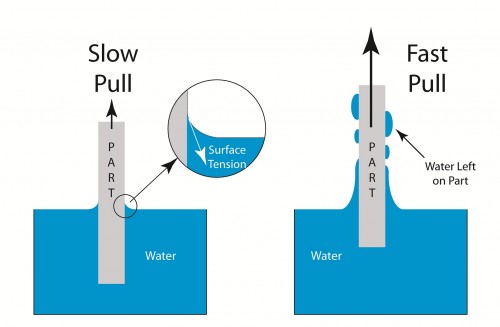One of the more recent developments in minimizing the water left on a part after rinsing is “slow-pull.” Slow-pull is usually applied as the parts exit the rinse that immediately precedes drying. Instead of removing the parts from the rinse at a rapid rate, usually measured in feet per minute (or even feet per second), they are withdrawn from the rinse at a rate measured in inches per minute. The effect is that the surface tension of the water works along with gravity to drag liquid from the part. In some cases, a slow-pull procedure will result in a completely dry part!
The short video below illustrates the effect of slow pull using a piece of aluminum window screen and a container of water. If the screen is withdrawn from the water quickly, water remains in the openings. If the screen is withdrawn from the water slowly, it emerges nearly dry!
The mechanism of slow-pull as a means to remove liquid from a surface is quite simple. The surface tension of the liquid results in a force which literally pulls water from the surface. This mechanism, however, requires some time to allow forces to balance. Removing the part slowly provides the time required for the balance of forces to occur and strip water from the part.

As is the case for most processes, slow-pull does not work on all part geometries nor does it work on all part substrates. It is especially effective on parts which can be fixtured so that large, flat surfaces are perpendicular to the plane of the surface of the liquid. Examples of this would be optical lenses, silicon and other wafers found in the electronics industry and precision stampings among others. Slow-pull is more effective on smooth or polished surfaces than it is on rough surfaces as water tends to cling to rough surfaces more readily than it does to smooth surfaces. Parts with surfaces that are somewhat hydrophobic when clean are also better candidates than hydrophilic surfaces which develop a strong bond with water. Many plastics, glass, and highly polished metal surfaces are all good candidates for slow pull drying.
Another factor which influences the effectiveness of slow-pull is the surface tension of the water. High quality de-ionized water (> 1 meg-ohm), for example, has much higher surface tension than water containing dissolved solids. Water with even small amounts of detergent residue will significantly reduce the effectiveness of the slow pull process. Temperature also plays a role as surface tension changes with temperature. Lower temperature results in higher surface tension and will, therefore, give a better slow-pull effect.
Note – When considering the use of slow-pull as an aid to drying, one faces the task of balancing the benefits of increased rinse temperature in helping evaporate remaining water vs. the benefits of lower temperature in improving the slow-pull effect. In many cases, a properly tuned slow-pull process will leave parts almost completely dry thereby reducing the importance of evaporation as a drying means.
Where it is applicable, slow-pull serves to significantly reduce residues left on the parts after drying even if it doesn’t leave them completely dry exiting the rinse. This is because slow-pull actually removes water rather than leaving it on the part to evaporate. Less water left on the part means less residue left behind.
Slow-pull is just one of many tools that can be used to enhance drying. Please search “drying” for more useful information on drying processes.
– FJF –



 English
English Spanish
Spanish Chinese
Chinese Canada
Canada Mexico
Mexico United Kingdom
United Kingdom



